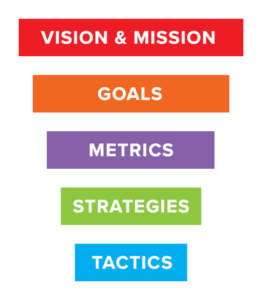Setting Website Goals When You’re Stumped
Does your nonprofit have clear goals for its website?
I’m not one of those guys who’s going to tell you to “run it like a business”—because I know that nonprofits do have separate constraints and circumstances from for-profit enterprises.
Even so, your nonprofit does have one thing in common with all (most?) companies.
Goals.
The problem is that many nonprofits don’t take the time to identify these goals or bake them into the strategy of developing and updating their website.
Or, at least, they don’t do their due diligence when creating their goals.
Rather than identifying key, strategic objectives for the site, they end up with goals like, “make it look pretty,” or, “make sure people can donate.”
These are features—not goals. Big difference.
But don’t feel bad if you’ve fallen for this trap before. It’s remarkably common. And coming up with actual goals for your website can be a bit difficult to do in a vacuum. How are you supposed to know what constitutes a good goal and what’s a ludicrous pipe dream?
So, when it comes to goal setting, you might feel stumped.
Fortunately, there’s a process by which you can set your website goals. When we work with our clients, we use this process to help them take vague ideas and distill them into realistic, actionable goals and metrics.
Here’s how your nonprofit can set (good, actionable, achievable) goals when you feel stumped:
Start with your vision
Before we help you define the goals for your website, you first must have a vision for your entire organization. Chances are, you have that already. But you’ll also need a vision for your ideal website.
Why does this matter?
No matter what kind of organization you’re with, your website is probably a central system that operates a big part of your day-to-day programs, outreach, communications, and marketing.
And if it isn’t, your organization probably isn’t living up to its online potential. This isn’t 1994. Taking advantage of digital channels means having a website that’s more than a fundraising brochure.
For many potential supporters, constituents, and stakeholders, your online presence is your presence—period. Click to tweet this.
It’s where most people discover you, where they find relevant information, how they make donations, and why they care about you in the first place.
It’s important to think about the larger vision for your organization and then craft a vision for your website specifically. Unless you do this, your goal-setting (and your website’s ability to help you achieve your vision) will fail.
Your website vision statement doesn’t have to be pages long or take months to craft. In fact, just like a good vision statement for your organization, it needs to be short and to the point. Think 3 sentences or so.
Weebly has a good article on creating a vision statement for your website, if you’d like to learn more. Here’s an example website vision statement from their article:
“Acme teaches site visitors about health insurance, encourages them to provide the information we need to give them a quote, and then helps those users through the screening process. The website’s goal is to not only get the attention of potential customers, but to also earn their trust. Once they apply, one of Acme’s agents guides them through the process.”
If you don’t have a vision for where your website is going, how do you expect it to get there?
How goals tie into your vision
From your vision, you can start to identify specific goals for your website that will help you realize that bigger picture.
For example:
Vision: Transition to an online fundraising model and away from direct mail
Turns into:
Goal: Raise $25,000 by year-end through online donations

Based on these goals, you will be able to identify the low-level metrics that are important for you to measure and control. (More on that later.)
And those metrics will point you toward specific strategies and tactics that you’ll execute in order to achieve your goals and realize your vision.
The point here is that organizations dive headfirst into goals and choose ones that do not properly align with or support their overall vision. Or, worse yet, they choose tactics and strategies for their website without a set of overarching goals. Click to tweet this.
In either scenario, the website is set up for failure because it is created in a vacuum rather than in context of the overall organization’s needs and direction.
Avoid this by first mapping out a clear vision for the entire organization and then translating that into goals that relate specifically to the website.
Define goals by focus area
You might be thinking:
Yeah, yeah, I get it. Set goals based on vision – duh. But how do I do that? How do I make sure I’m choosing the right metrics?
Before we jump into prescribing specific KPIs, goals, or metrics for the website, let’s first understand at a basic level which areas of our website are important places for us to have goals.
We call these focus areas.
Why do we bother with focus areas?
Think about the last time you chose a restaurant. Here’s how the conversation probably went:
You: Okay, so what do you want to eat?
Friend: I don’t know, what do you feel like?
You: Asian food sounds good – or maybe Greek?
Friend: Yeah! But I don’t want to drive more than 10 minutes to pick it up.
You: Okay, let me fire up Google Maps/Yelp/TripAdvisor and see what’s around here…
See what just happened there?
Without thinking about it, you and your friend just narrowed down a list of hundreds of potential options in a matter of moments by narrowing your focus to a few specific types of food. This helped you reduce your choices to a manageable number, allowing you to actually make an informed decision.
Choosing focus areas is the same idea.
So, start with a list of high-level areas where you’d like to focus your efforts. These could be things like:
- Awareness: Overall visibility of the website/organization
- Fundraising: Raising more money online
- Engagement: Getting people to return to the site, come to an event, or volunteer
- Advocacy: Getting visitors to promote your website to others, or take action on your behalf
With these focus areas, you’re better able to connect the dots between your organization’s vision and the specific goals (or KPIs) for your website that you’ve chosen to be most important.
So, you may identify KPIs such as:
- Awareness:
- Overall traffic to the website
- Search engine rankings
- Fundraising
- Total donations generated ($)
- Donor lifetime value
- Engagement
- Volunteers recruited
- Newsletter subscribes
- Advocacy
- Social media shares
- Petitions signed
The goals that you define for your website will tell you, at a high level, how well your website is doing at serving your shop’s vision.
But we need to take one more step to make these these goals actionable. We need to define metrics.
Going from goals to metrics
Your metrics are the lower-level, tactical inputs that correlate with your KPIs (goals).
In practice, it’s certainly possible to want your site to receive more traffic or generate more donations. But those KPIs are not actionable—you can’t directly control them. You need metrics that give you levers to pull and knobs to twist in order to affect higher-level outcomes.
Let’s look at the example of your KPI for donations.
- KPI: Donations generated ($)
- Metric: Conversion rate from donation page
- Metric: Click-through rate on “donate” button from homepage
- Metric: Average donation amount
Whereas there is not a single way to directly affect the number of donations generated, you can implement and test different tactics and features in order to change–say–your conversion rate on the donation page.
If you decide to test a streamlined version of the form that increases your conversion rate from 50% to 60%, then you should presumably see an increase in your KPI of total donations generated.
In summary: the metrics you define will allow you to take control of your high-level KPIs by giving you leading indicators that are predictive of your larger goals.
As part of a continuous web optimization process (or Growth-Driven Design), we often use this cycle over and over again to help drive results.
Measure, Test, Learn
The most important part of this process is to recognize that it is not done once and then left to sit.
By the very nature of your top-down, vision-driven strategy, you must continue to test and experiment with tactics to change and improve the KPIs that define your success.
So, begin by simply observing. Perform a weekly or biweekly analysis of the KPIs and metrics/leading indicators and keep a running scorecard of the numbers.
From that, project out over time what results you can expect to see over the next 3, 4, 6, or 12 months. Do these projections put you on a path to meet your goal? If not, then you’ll need to begin making adjustments to improve the metrics and raise (or lower) your KPIs.
In order to accomplish this, you design a series of controlled experiments where you will make incremental, tactical changes to your website in order to improve the metrics that you have defined for each goal.
For example, you may test changing the default donation amount on your page from $5 to $10 in hopes of increasing your average donation.
Or, you might change the color of your “Donate Now” button to attract more clicks.
Over time, you will test each of these small changes to see what effect it has on your metrics and, by extension, your KPIs.
Keep in mind that small experiments typically lead to small gains. If you want to get a big win, you often need to make a more drastic change. But the principal is still the same—change, then measure.
As you continuously learn from the experiments, you can improve the performance of your website and drive toward your ultimate goals.
In doing so, you have connected the process all the way from the big picture to the individual tasks and day-to-day work that will help you achieve what you set out to accomplish.
Having goals for your website is important. But you also need to have a direct line from the vision of your organization all the way down through the tactics and individual features and functionality that you prescribe for the site. Click to tweet this.
So, no more being stumped. Start with your organization’s mission and work your way through the process in order to define goals and a strategy that’s right for your website. In doing so, you’ll discover the actionable metrics and tactics you should be using today to drive more impact for your nonprofit tomorrow.





